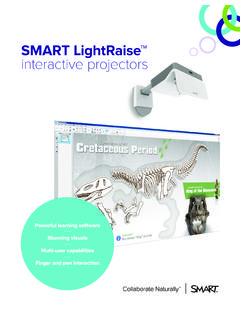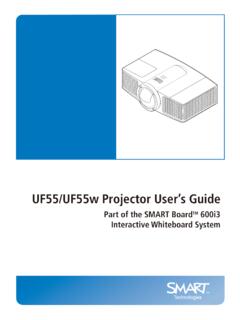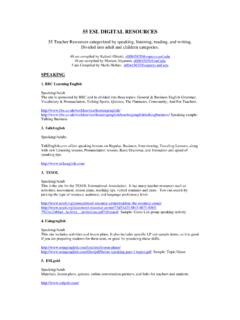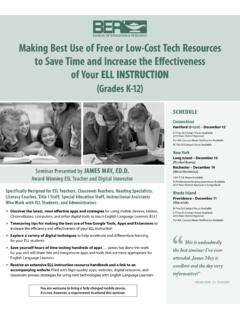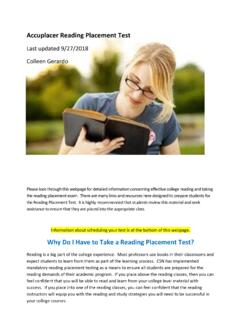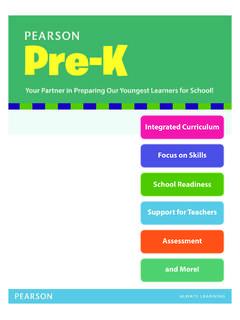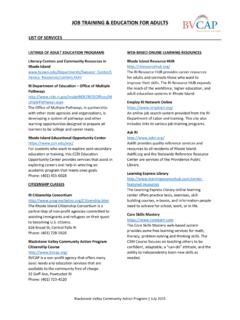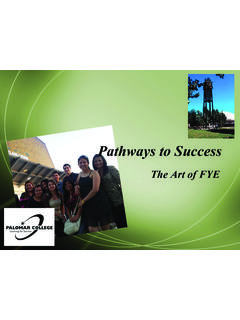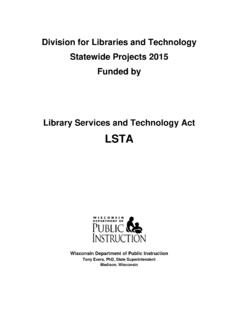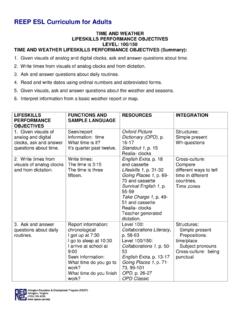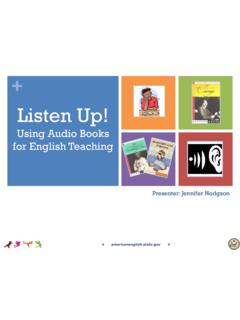Transcription of Creating Classrooms for Everyone - Smart Technologies
1 White Paper Creating Classrooms for Everyone How Interactive Whiteboards Support Universal Design for Learning Creating Classrooms for Everyone : How Interactive Whiteboards Support Universal Design for Learning 2 This white paper is for informational purposes only, is subject to change without notice and should not be construed as offering any future product commitments on the part of Smart Technologies ULC. While significant effort has been made to ensure the accuracy of the information, Smart Technologies ULC assumes no responsibility or liability for any errors, omissions or inaccuracies contained herein. 2009 Smart Technologies ULC. All rights reserved. Smart Board, the Smart logo, all Smart taglines and smarttech are trademarks or registered trademarks of Smart Technologies ULC in the and/or other countries. All other third-party product and company names are for identification purposes only and may be trademarks of their respective Classrooms today are filled with a diverse range of students.
2 Many of them have grown up with computers and the Internet. Some are primarily visual learners, some are auditory learners and some kinesthetic. Some speak English as a second language. Others may be gifted and talented. Still others may struggle with physical, mental, behavioral or emotional challenges. In the 2003 2004 school year alone, the Department of Education reported 14 percent of students, or nearly 6 million learners, required Individualized Education Programs (IEPs), 11 percent needed English Language Learner (ELL) assistance, and 36 percent, or million, qualified for free or price-reduced lunches (Hoffman and Sable, 2006). Not surprisingly, teachers find their workloads steadily increasing as they struggle to keep up with the demands of more complex student populations. A Canadian Teachers Federation survey noted an increase from an already heavy work week in 2001 to an even more demanding week in 2005 (Price, 2005).
3 In the UK, the National Union of Teachers cites workload as the major cause of stress and the primary reason for teachers leaving the profession (Andalo, 2008). Given the demanding environment teachers inhabit today, many wonder how a sometimes dizzying array of new classroom technology can truly help manage differentiated learning, engage digital learners and save time. Many technology solutions, including interactive whiteboards, are offered to ease the challenge of teaching in today s Classrooms . While few would deny the need for technology-enabled Classrooms , how can educators determine which technology solution is right for any given learning environment? With myriad products to consider, budgets to balance and ever-changing trends to watch, evaluating technology can seem daunting. A useful approach may be found in Universal Design for Learning (UDL).
4 UDL has its roots in architecture s universal design movement, which advocates designing structures and products that can be used equally well by Everyone , whether or not they have disabilities. Borrowing from the principles of universal design, UDL can provide a framework for evaluating which products have the potential to work best for all learning environments. This paper examines UDL standards and how they can help guide the evaluation and use of interactive whiteboards in today s Classrooms . Creating Classrooms for Everyone : How Interactive Whiteboards Support Universal Design for Learning 3 History: Universal design for learning In the , the movement toward barrier-free design began to gain momentum in the 1950s. At that time, wheelchair ramps, audio systems, automatic doors and other adaptations helped reduce barriers for people with physical limitations (Center for Universal Design, ).
5 As policies and legislation set new standards for accessibility in subsequent decades, new ideas began to emerge. People envisioned products and structures that could be used by Everyone , without expensive or unsightly adaptations, setting the stage for universal design (Center for Universal Design, ). Universal design differed from barrier-free design as the latter solution was geared more toward retrofitting or adapting existing structures and environments than considering the needs of all people during the design process itself. Ron Mace, the founder of universal design, described his philosophy as the design of products and environments to be usable by all people, to the greatest extent possible, without the need for adaptation or specialized design (Center for Universal Design, ). For example, where accessibility might previously have meant adding a wheelchair ramp to an external set of stairs leading into a building, the universal design approach would be to design access to a building at street level or via a mild slope, which accommodates Everyone with the same nonstigmatizing solution.
6 From the 1960s to the turn of the 21st century, significant legislation was passed to protect the rights of people with disabilities. These laws influenced the adoption of universal design as architects realized the aesthetic, financial and humanitarian benefits of building designs that worked for Everyone . In 1997, the Center for Universal Design at North Carolina State University published seven principles of universal design: 1. Equitable use the design is useful and marketable to people with diverse abilities 2. Flexibility in use the design accommodates a wide range of individual preferences and abilities 3. Simple and intuitive use use of the design is easy to understand, regardless of the user's experience, knowledge, language skills, or current concentration level 4. Perceptible information the design communicates necessary information effectively to the user, regardless of ambient conditions or the user's sensory abilities Creating Classrooms for Everyone : How Interactive Whiteboards Support Universal Design for Learning 45.
7 Tolerance for error -- the design minimizes hazards and the adverse consequences of accidental or unintended actions 6. Low physical effort the design can be used efficiently and comfortably and with a minimum of fatigue 7. Size and space for approach and use appropriate size and space is provided for approach, reach, manipulation and use regardless of the user's body size, posture or mobility (Center for Universal Design, ) From architecture and product design, the ideas behind universal design spread to other disciplines, including education. There, through differentiated instruction and IEPs, the challenge is not only to reduce barriers for students with special needs, but also to improve the learning environment for all by helping to individualize instruction. In 1984, a group of education researchers and clinicians founded the Center for Applied Special Technology (CAST), to explore ways of using computer Technologies to improve education for all children, especially those with disabilities (CAST, ).
8 Influenced by universal design guidelines, CAST researchers explored how education could be individualized through a flexible approach to teaching methods and materials, which they called universal design for learning, or UDL. Their work led them to develop alternatives that would not only reduce barriers for individuals with special needs, but would also enhance learning for all students. According to CAST, addressing the divergent needs of special populations increases usability for Everyone (Rose and Meyer, 2002, section ). In the course of their research, CAST developed three enduring principles of UDL: 1. Provide multiple means of representation give learners various ways to acquire information and knowledge 2. Provide multiple means of action and expression give learners alternatives for demonstrating what they know 3. Provide multiple means of engagement tap into learners interests, offer appropriate challenges and increase motivation (Rose and Meyer, 2002, section ) Creating Classrooms for Everyone : How Interactive Whiteboards Support Universal Design for Learning 5 UDL principles provide insight into how noninclusive curricula and reliance on traditional media, such as printed texts, lead to a one-size-fits-all approach, which misses the mark for many learners, regardless of whether or not they have special needs.
9 In such contexts, the onus to adapt is placed on students, as noted by Thomas Hehir in Eliminating Ableism in Education : We often attempt to retrofit the child with inappropriate interventions after they have failed in school, rather than design the instructional program from the beginning to allow for access and success (Hehir, 2002, ). When educational Technologies and curricula embed UDL principles, they ensure students can access, use and engage with learning materials in multiple ways. This flexibility more effectively supports the needs of all learners (Rose and Meyer, 2006). UDL principles and interactive whiteboards Interactive whiteboards are designed to engage a wide variety of students in the learning process. They evolved from constructivist pedagogy and support each of the three principles of universal design for learning.
10 The product provides teachers with multiple ways to represent information using interactive text, images, sound and video files, and thus engage a broad range of learners. Students can use the same features of the product to demonstrate their understanding of a topic. Touch-sensitive boards in particular give multiple options for interacting with displayed information, including by finger, pen tool or other object. Finally, interactive whiteboards captivate learners of the digital age, increasing student engagement with instant, tactile access to digital resources. The following sections review these principles in greater detail. Multiple means of representation Interactive whiteboards and differentiated learning One of the key strengths of interactive whiteboards are their ability to simplify and speed the process of sharing information using a variety of media formats, either as planned or spontaneous elements of a lesson.
